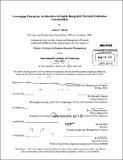| dc.contributor.advisor | Ricardo Valerdi and C. Robert Kenley. | en_US |
| dc.contributor.author | Sheets, Arlan C. (Arlan Christopher) | en_US |
| dc.contributor.other | System Design and Management Program. | en_US |
| dc.date.accessioned | 2012-05-15T21:16:20Z | |
| dc.date.available | 2012-05-15T21:16:20Z | |
| dc.date.copyright | 2011 | en_US |
| dc.date.issued | 2011 | en_US |
| dc.identifier.uri | http://hdl.handle.net/1721.1/70835 | |
| dc.description | Thesis (S.M. in Engineering and Management)--Massachusetts Institute of Technology, Engineering Systems Division, 2011. | en_US |
| dc.description | Cataloged from PDF version of thesis. | en_US |
| dc.description | Includes bibliographical references (p. 62-64). | en_US |
| dc.description.abstract | An analysis was performed to investigate how enterprise architecting methods can be applied to an integrate test and evaluation enterprise and make it a more sustainable enterprise to provide continuous value in the face of an evolving DoD landscape. Enterprise sustainability is the ability of an enterprise to maintain economic viability through optimal resource management and preservation over an extended duration. Through the application of the eight lenses of enterprise architecting, it was found that a more holistic understanding of a Major Range and Test Facility Base (MRTFB) enterprise's current state could be achieved. This approach also supported identifying gaps that exist between the ability of the current-state MRTFB to deliver value and the value delivery that is required by its key stakeholders. The importance of expanding the information view of enterprise architecting to encompass the entire enterprise infrastructure was also studied. Through the expansion of the information view to an infrastructure view, a more complete depiction of the MRTFB enterprise was achieved. The specific importance of the energy infrastructure to a sustainable enterprise was also explored. Through the application of enterprise architecting, the interrelations between the energy infrastructure and the other views, such as processes, services, and knowledge, and the other supporting infrastructure components, such as facilities, land, physical assets, communication networks, and IT networks, can be established. It was found that the energy infrastructure is a core enabler for our technology-based society, and coupled with the current societal focus on green and sustainable energy provides a focal point for enterprises to leverage and initiate transformation efforts to align the energy infrastructure with larger enterprise strategic objectives. | en_US |
| dc.description.statementofresponsibility | by Arlan C. Sheets. | en_US |
| dc.format.extent | 64 p. | en_US |
| dc.language.iso | eng | en_US |
| dc.publisher | Massachusetts Institute of Technology | en_US |
| dc.rights | M.I.T. theses are protected by
copyright. They may be viewed from this source for any purpose, but
reproduction or distribution in any format is prohibited without written
permission. See provided URL for inquiries about permission. | en_US |
| dc.rights.uri | http://dspace.mit.edu/handle/1721.1/7582 | en_US |
| dc.subject | Engineering Systems Division. | en_US |
| dc.subject | System Design and Management Program. | en_US |
| dc.title | Leveraging enterprise architecture to enable integrated test and evaluation sustainability | en_US |
| dc.type | Thesis | en_US |
| dc.description.degree | S.M.in Engineering and Management | en_US |
| dc.contributor.department | System Design and Management Program. | en_US |
| dc.contributor.department | Massachusetts Institute of Technology. Engineering Systems Division | |
| dc.identifier.oclc | 793203118 | en_US |
